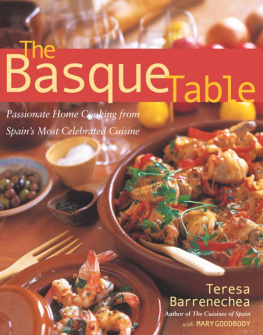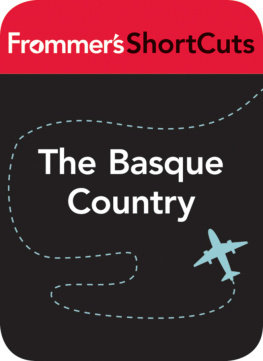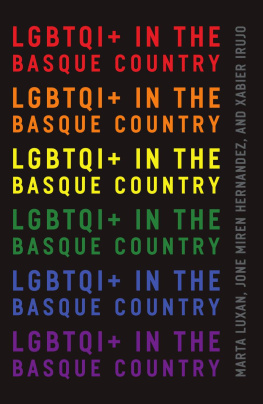
Ama, tu me has enseado todo lo que sabes.
He escrito este libro para t con mucho cario.
T HE H ARVARD C OMMON P RESS
535 Albany Street
Boston, Massachusetts 02118
Copyright 1998 by Teresa Barrenechea
Illustrations copyright 1998 by Joanna Roy
All rights reserved. No part of this publication may be reproduced or transmitted in any form
or by any means, electronic or mechanical, including photocopying, recording, or any information
storage or retrieval system, without permission in writing from the publisher.
Printed in the United States of America
Printed on acid-free paper
The Library of Congress has cataloged the hardcover edition as follows:
Barrenechea, Teresa
The Basque table : passionate home cooking from
one of Europe's great regional cuisines / Teresa
Barrenechea, with Mary Goodbody.
p. cm.
Includes index.
ISBN 1-55832-140-3 (hardcover : alk. paper).
1. Cookery, Basque. 2. Food habitsSpainPas Vasco.
I. Goodbody, Mary. II. Title.
TX723.5.S7B37 1998
641.5946'6dc21
98-29295
ISBN-13: 978-1-55832-327-8
ISBN-10: 1-55832-327-9
Special bulk-order discounts are available on this and other Harvard Common Press books.
Companies and organizations may purchase books for premiums or resale, or may arrange for a
custom edition, by contacting the Marketing Director at the address above.
Cover design by Night & Day Design
Cover photograph by Rita Maas
Maps by Charles Bahne
Text illustrations by Joanna Roy
Interior design by Barbara M. Bachman
2 4 6 8 10 9 7 5 3 1
PINCHOS
Pinchosor pintxos, as the Basques spell the wordare the Basque Country's singular form of the better known Spanish tapas. The term derives from the Spanish word pinchar, "to prick," because originally pinchos were always served skewered on wooden toothpicks. Today they may be served either on toothpicks or in small earthenware bowls or on platters; they are eaten as finger food. In concept pinchos are similar to tapas; both are bites of tasty nourishment shared with friends in bars and taverns. But tapas evolved in southern Spain, from the old-time practiceof laying a slice of bread or meat across the top of a sherry glass (their name derives from the word tapar, "to cover"). Today tapas must usually be eaten with a fork or spoon, and whereas tapas may be small servings of any dish, pinchos are a distinct set of little dishes that are never served at meals.
Of course, the social interaction surrounding pinchos is as important as the food. We Basques greatly enjoy meeting friends before lunch or dinner for a small glass of wine and a few pinchos. It is a time when we can discuss the latest soccer game, a new love affair, or, of course, a recipe. And when a delicious little morsel accompanies our conversation, so much the better!
The pinchos I present here are traditional ones, authentic combinations of foods such as hard-cooked eggs, shrimp, anchovies, olives, ham, asparagus, and mushrooms. No matter how simple the preparation, we use fresh, delicious ingredients when we assemble pinchos. And it is not only barkeeps who assemble them. Many home cooks serve pinchos at parties and casual gatherings. They are easy to make and look pretty and inviting on a tray. The innovative chefs working in nueva cocina restaurants in the Basque Country may be taking pinchos to new heights with exotic combinations of foods and spectacular presentations, but I think the simple ones collected here are excellent samples of these tiny treasures.
Potato Omelet
T ORTILLA DE P ATATA
Makes 20 pinchos
There is not a bar or a party in Basque Country that does not offer tortilla de patata as a pincho. This extremely popular dish is excellent accompanied by a small glass of wine, but it can also be cut into large pieces and served as a light entre with a green salad, making a fine light meal for vegetarians, especially. Tortilla de patata is also common picnic fare, and it's a popular sandwich, or bocadillo, filling. I make this omelet often, and it has saved me more than once when I had to make an unplanned meal, because the ingredients are household staples.
The omelet may sound complicated to make, since it is removed from the pan and then returned for further cooking, but after you have tried this once or twice, you will find it is very easyas long as you have a plate that is a little larger in diameter than the pan.
| 1 | cup olive oil |
| medium onion, chopped |
| 3 | medium potatoes, cut into teaspoon-sized pieces (about 1 pound) |
| Salt |
| 4 | large eggs |
- In a large skillet (about 10 inches in diameter), heat the olive oil over medium-high heat. Add the onion, and saut it for about 5 minutes, until it is light golden. Add the potatoes, and season them to taste with salt. Reduce the heat to medium, and cook the potatoes for about 15 minutes longer, stirring, until they are tender.
- Raise the heat to medium-high, and cook the potatoes for 1 to 2 minutes longer, until they are lightly browned, crisp on the outside, and soft on the inside. Using a large slotted spoon, remove the potatoes and onion from the pan, and drain them in a colander or on paper towels. Let the oil in the pan cool slightly, then pour all but about 1 teaspoons into another container to use later.
- In a large bowl, beat the eggs lightly. Add the potatoes and onion, and mix well. Set the mixture aside for a few minutes.
- Heat the skillet over high heat, tipping the pan to assure that the oil is evenly distributed. When it is very hot, pour the egg mixture into the pan. Use a spatula to spread the mixture evenly in the skillet. Shake the pan gently to prevent sticking and burning, and cook the omelet for about 1 minute. Reduce the heat to medium, and continue cooking the omelet for 2 or 3 minutes longer, until the eggs begin to set around the edges.
- Lay over the skillet a plate that is slightly larger in diameter than the skillet. Using one hand to hold the plate in place, invert the omelet onto it. (Do this over a clean work surface for insurance.)
- Return the empty skillet to the stove, add another 1 teaspoons of the reserved oil, and heat it over high heat. When the oil is hot, slide the omelet off the plate and into the pan (the uncooked side should be facing down). Shake the pan gently to prevent sticking, and cook the omelet for 1 minute. Reduce the heat to medium, and cook for about 3 minutes longer, until the omelet is set. Slide the omelet onto a serving plate, and let the omelet cool.
- Cut the omelet into 20 small squares or wedges, and serve them skewered with toothpicks or on top of thin slices of bread.
Croquettes
C ROQUETAS V ARIADAS
Makes 15 pinchos
Nobody likes croquettes more than Basquesdo. We often eat these tasty little morsels before lunch or dinner with a glass of wine, and sometimes we serve them at a cocktail party or as a light meal; children, especially, like them for supper. I have made this master recipe with salt cod, because it is so popular in the Basque Country, but you can substitute the same amount of chopped ham, chicken or turkey, beef, or chorizo sausage meat for the salt cod (making croquettes is a terrific way to use scraps and leftovers from other dishes). Sometimes we make a variety of croquettes and form them into slightly different shapes so that our guests know that one is different from the others.
Next page








